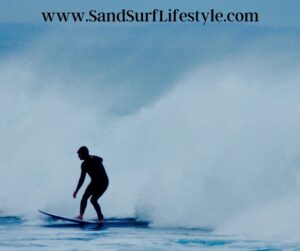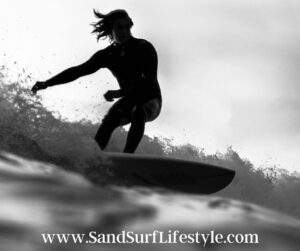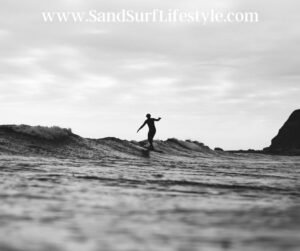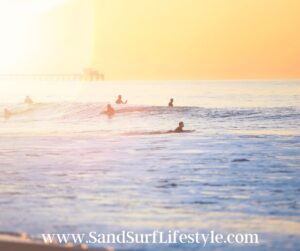The sport of surfing has become quite popular. 50 million people around the world identify as either casual or professional Surfers, per Surfing Waves. There are four classes of surfers; Beginning, Intermediate, Advanced, and Professional. According to Surf Line, an intermediate surfer (or rider) is a surfer who can successfully paddle it alone and catch and ride waves to a logical finish. They can also execute three turns, which are the bottom turn, top turn, and cutback.
Here are five helpful tips which can help an intermediate surfer with their surfing skills.
Choose the Right Surfboard:

Choosing the right surfboard is an essential part of surfing, whether you are a beginner, an intermediate, advanced, or professional. However, just as there are different skill levels for surfers, there are different surfboards for each level.
According to Isle Surf and Sun, the right surfboard for intermediate Surfers should be equal to their height or up to six inches shorter than their height. If you are going to go with a shorter board, remember to get one that is thick and wide to keep the board’s volume.
As far as design is concerned, intermediate Surfers should choose
fish surfboards and grovelers. Surf Hungry has composed a list of the top surfboards for intermediate surfers. A few of those boards include:
● South Bay Board Co. Soft Top Surfboard
● North Gear Ocean Beach Foamie Surfing Thruster Surfboard
● BIC Sport DURA-TEC Surfboard
● Wavestorm 8′ Classic Surfboard
● Wave Bandit Shred Sled 48” Twin Surfboard
Why is choosing the right surfboard so important? Because the right board can make sure that your wave count doesn’t go down if you lack surfing fitness, per Boardcave. I believe that the right surfboard can make all the difference in the world when it comes to having a good day of surfing or a bad day of surfing. Now make sure you choose the right board, get out on those waves, start honing your surfing skills to get better!
Body Position
Having a good stance is essential to a successful day of surfing. Barefoot Surf Travel states that you need to maintain a low center of gravity while surfing. To achieve this, you should bend your knees and hips while ensuring that your chest and upper body are straight.

What position is another key factor in helping you achieve the perfect stance? Barefoot Surf Travel states that both of your feet must be centered on the width of the surfboard. Your foot arches should be positioned identically on each side of the stringer. If your board
doesn’t have a stringer, just imagine a line down the middle of your board, and place your arches on either side of the imaginary line. Your feet should be approximately shoulder-width apart.
Balance is a key factor in being able to surf. The website surfingpghpe.com states that balance is the most important part of your fitness on surfing. Your ability to keep your balance will also have a positive impact on your stance. Making one slight mistake regarding your balance can result in serious injuries or falls.
Having very small or very large fans can be quite detrimental to your surfing. Large or small stances make it hard to distribute your weight evenly on the board, which will result in quite a few falls. Once you master the proper stance oh, you will see vast improvements in your surfing.
Do you know how to paint a surfboard before glassing? Find out here.
Your Head Controls You
Per the website Surf The Greats, your head does so much more than control your thoughts, fears, and emotions when you are surfing. When you are surfing, think of your head like a steering wheel that can control wherever you go.
As is the case in most sports, when you are surfing, the direction in which you are looking is where you will end up. Head positioning is also important to your balance hi. It is important to remember to lead with your head and keep it centered over your body. This will ensure that you have proper head positioning, which will lead to better balance and will help you to keep your eyes where you want to go.
When you are out surfing the waves, trying to get better oh, I would strongly recommend practicing your head positioning. Most people do not realize the importance of the position of their head when they are surfing oh, but it is an important aspect of your stance. Having a good stance is essential in surfing, and it is a key factor in improving your surfing skills.
Learn To Read Waves
 To be able to read waves, you must first understand the different stages of waves. They are:
To be able to read waves, you must first understand the different stages of waves. They are:
● Stage A – At this stage, the wave is only a bump with no break.
● Stage B – this stage, the waves still has no break but it is perfect for servers who want to catch a “green wave.”
● Stage C – At this stage, the wave is finally breaking.
● Stage D – this is the stage where the wave has broken and has become a white water wave.
Book Surf Camp stresses The Importance of being able to read waves, whether you are a beginner, an intermediate surfer, or an experienced surfer. To be able to read waves, he will first have to recognize the different parts of a wave. The different parts of a wave are:
● Peak – Also called the craft, this is the highest part of the wave and the first part of the wave that breaks.
● Lip – this is the upper part of the way that pitches above us. A lot of the wave’s power can be found in the lip.
● Shoulder – Also referred to as the face, the shoulder is the part of the wave that has not broken yet.
● Curl – This is also referred to as the pocket. The shoulder is a steep, concave part of the wave.
● Impact Zone – This is the part of the wave that crashes into flat water.
● Whitewater – This is the section of the wave that has already broken.
● Tube – This is the cylindrical section of the wave that forms when they break.
Once you know the different stages of a wave, and how to identify the different parts of a wave, it’s time to learn how to read the wave. Book Surf Camps say that the following steps are the best way to read and catch a wave:
● Identify the peak, and paddle quickly towards it.
● If you were not able to make it to the peak, the ideal takeoff spot is in the curl.
● Turn your surfboard to the point where it is facing the beach, and position yourself in the direction in which the wave is breaking.
● If the angle of the shoulder is steep, the wave will break slowly.
● Don’t get too close to the peak when it is breaking.
● The farther away you are from the peak of the shoulder, the less power the wave will generate.
● Position yourself behind the wave in the water if you don’t want to catch it.
Now that you are informed of the different stages of waves; the different parts of a wave; and how to read a wave, it’s time to get out in the ocean and put all of this knowledge to practice.
Learn From Your Fellow Surfers
 One of the best methods to improve in any sport is to watch and mimic those that are better than you. This holds true in surfing as well. If you are surfing at an intermediate level, I think that you will learn a lot by watching surfers who are at an advanced level.
One of the best methods to improve in any sport is to watch and mimic those that are better than you. This holds true in surfing as well. If you are surfing at an intermediate level, I think that you will learn a lot by watching surfers who are at an advanced level.
Perhaps the best way to learn from your fellow surfers is to find a surfer that is much more advanced than you, see if they are willing to share a few pointers with you. I have found that most people are pretty approachable, and are more than willing to impart a little wisdom when it comes to the sport of surfing.
One of the most important things to remember when trying to get a few tips from advanced surfers is to not be afraid. If you make yourself approachable, your fellow Surfers will be sharing their knowledge with you before you know it.
Conclusion
I believe that those who are surfing and at an intermediate level should be consistently practicing the five tips we have discussed and this article. By choosing the right surfboard; position your body and head properly; learning to read waves, and learning from your fellow surfers, you will be on your way to surfing and an advanced level in no time.
Please note: This blog post is for educational purposes only and does not constitute legal or medical advice. Please consult a legal expert or medical professional to address your specific needs.

